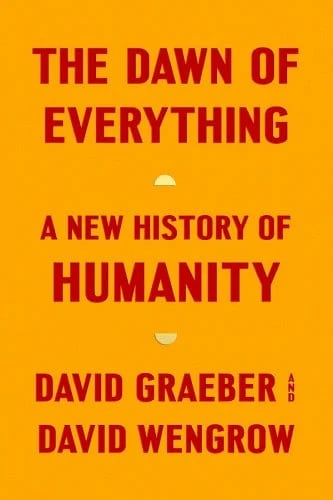Tell me if you’ve heard this one: Human societies inevitably follow a trajectory that starts with small hunter-gatherer bands or tribes, “progresses” to the adoption of agriculture, which leads to more settled-in-place societies and the creation of surplus, which then leads to class stratification, bureaucracies and cities, and eventually nation-states.
It’s a pretty common story, one that most of us learn or absorb at some point in our studies.
You’re less likely to have heard the other stories that archaeologist David Wengrow and anthropologist and economist David Graeber share in The Dawn of Everything: A New History of Humanity—stories upon stories of societies that break this assumed inevitability in just about every way you can imagine. They tell of egalitarian urban societies and hierarchical hunter-gatherers, societies that alternated seasonally between different modes of governance and sustenance, societies that chose to deemphasize agriculture even though they had access to it, and so on.

Wengrow and Graeber systematically use the archaeological and historical record to show that the ways groups of humans have organized themselves is wildly varied and does not move along any consistent or predictable trajectory. They do not argue that earlier societies were necessarily “better” (or worse), but they do argue that they had agency and made decisions about how they organized themselves—and sometimes changed those systems in reaction to calamities or failures or the example of neighbors.
In fact, the authors make a compelling claim that the whole idea of a one-way progression along that predefined path was intentionally created by Europeans grasping for a response to the serious intellectual challenges being posed about their economic and political arrangements by Native American thinkers.
The entire book is fascinating, but even if you’re not up for all 704 pages, I think everyone who spends time thinking about what’s possible in terms of housing and urban planning would be fascinated by a section in the middle of Chapter 9 (pages 337–345) devoted to Teotihuacan, Mexico. True to the verbose section headings of the book, this one is called “How the people of Teotihuacan turned their backs on monument-building and human sacrifice and instead embarked on remarkable project of social housing.”
[RELATED ARTICLE: Learning from Vienna and Vienna’s Social Housing Model]
The only misleading bit in that astounding statement is the word “how,” since the archaeological record is a bit sparse on the motivations and methods front. It does, however, show clearly that it happened: Around 300 C.E., Teotihuacan’s major central temples fell suddenly and perhaps violently out of use, and the city of 100,000 people (i.e., not a tiny town or commune where everyone knew one another) developed itself into a grid of communal apartment blocks. The city had neighborhoods of folks who had migrated in from the same place, but apparently no rich or poor ones, and there was a remarkably high standard of living for all. As Wengrow and Graeber describe:
“The evidence suggests . . . small groups of nuclear families, living comfortable lives in single-storey buildings, each equipped with integral drainage facilities and finely plastered floors and walls. Each family seems to have had its own set of private rooms with the larger apartment block . . . Even the more modest apartments show signs of a comfortable lifestyle, with access to imported goods and a staple diet of corn tortillas, eggs, turkey and rabbit meat, and the milk-hued drink known as pulque. . . Few were deprived. More than that, many citizens enjoyed a standard of living that is rarely achieved across such a wide sector of urban society in any period of urban history, including our own.” (pages 342–343)
Governed, at best understanding, through neighborhood councils, the city functioned this way for centuries.
Removing your priests and building housing for everyone might seem like a far cry from the kind of political avenues open to us today, but that’s exactly why I think it is relevant. In hindsight we often treat political developments as inevitable—they were always going to turn out the way they turned out. The Dawn of Everything makes a strong case that this isn’t so.





Thank you for this. I also thought this book was full of fascinating insights. Thank you for focusing on this particular one. Like you, the main takeaway I took from the book is that human societies are always thinking, tinkering, and trying out things in response to changing context and events. And that arc of progress we have convinced ourselves of puts blinders on us. There is always possibility for us, for doing better or worse. It’s inspiring to see examples of better.